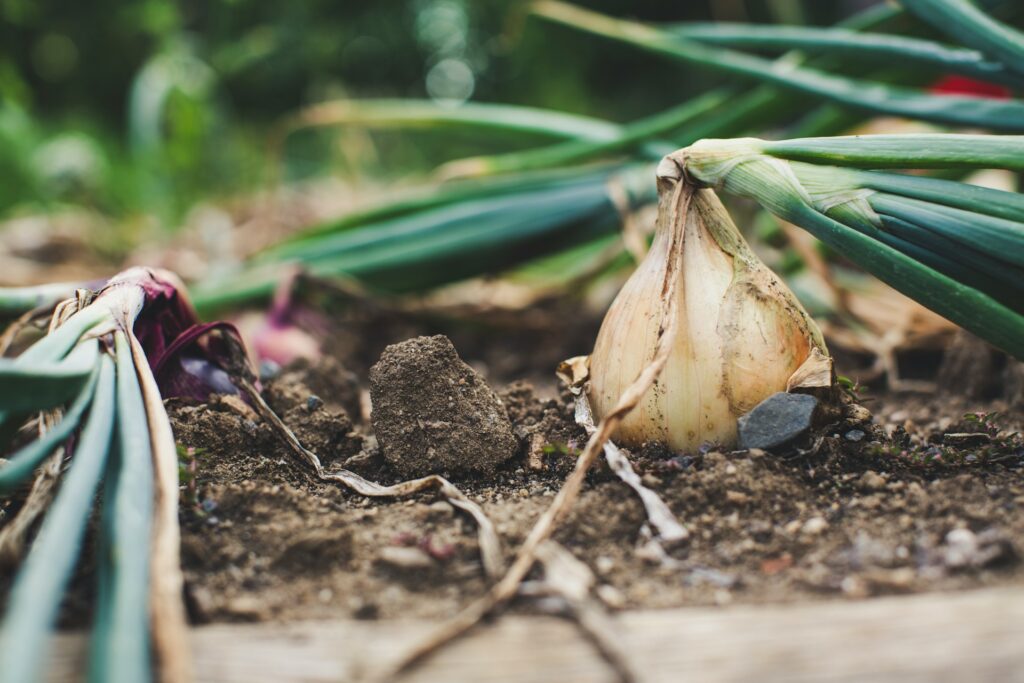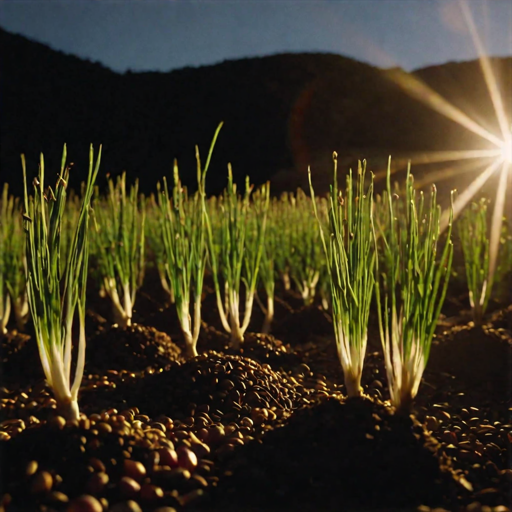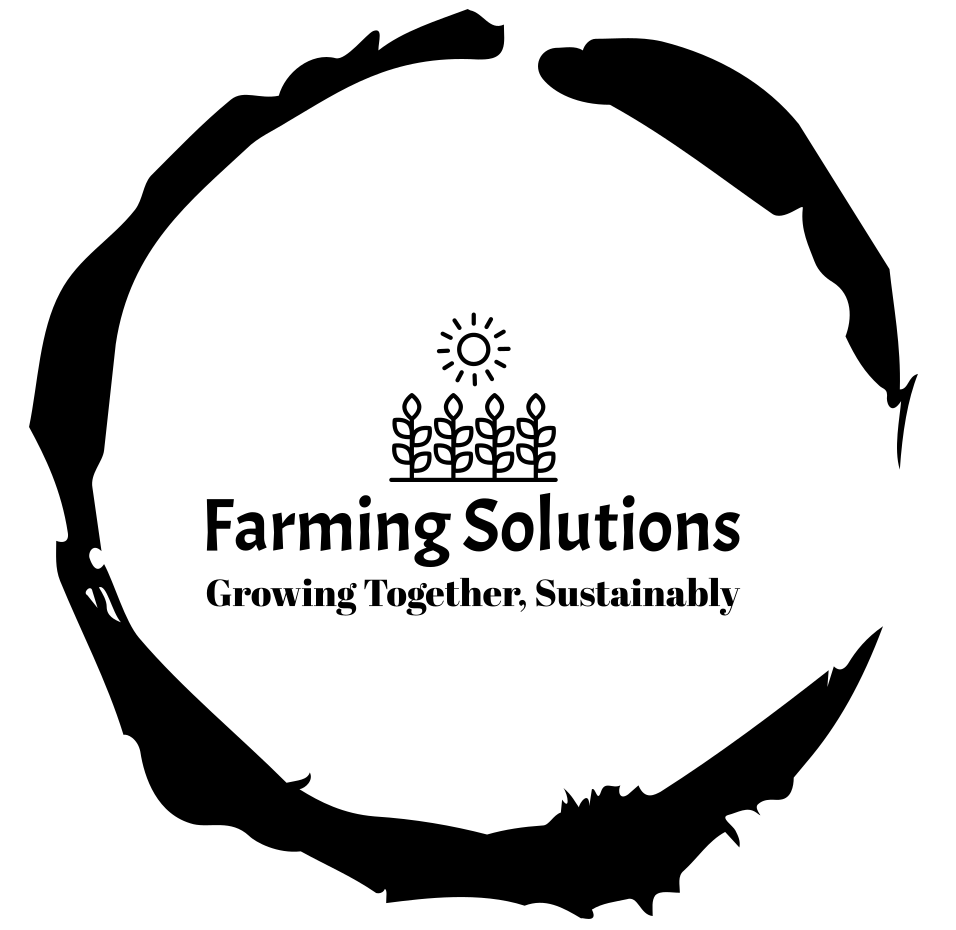
Learn efficient onion seed production techniques and storage tips. Explore how to optimize yield and preserve quality.
Onion is one of the most important spices crop of Bangladesh. It is also used as a vegetable. The leaves of onion and its stem are full of vitamin C and calcium. Onion is grown all over the country but main growing areas are Pabna, Faridpur, Jashore, Rajshahi, Bogura, Manikganj, Dinajpur, Kushtia, Maherpur, Kumilla, Tangail, Munshiganj, and Narsingdi. At present there is a large shortfall of onion in the country. This shortfall is met up through import every year. The onion production can be increased through using BARI developed HYV and improved production technology. But the availability of quality seeds of these varieties is one of the major problems. Hence, quality seed production technique is described below:

Clay loam soil is the best for onion seed production. Low lying, marshy and heavy clay soil are not desirable. Onion requires cool weather during its early development and during the early growth of the seed stalk. A moderately high temperature and a dry atmosphere favours the bulb maturity as well as seed production. Sunny clear day is favourable for insect pollination.
There are two methods of seed production. Most commonly used method of seed production is the bulb-to-seed method. Another method is seed-to-seed. The commonly used bulb to seed method is described here.
Bulb-to-Seed Method
Collection and selection of mother bulbs: Appropriate size, thin-necked, mature and disease free bulbs should be collected from farmer’s field and stored for replanting. Doubles and long thick-necked bulbs are discarded and only true-to-type bulbs are selected.
Time of planting: The optimum time for planting bulb is third week of October to Ist week of November. Late planting (December) results lower seed yield and chance to increase disease and insect-pests and crop damage by strong wind or hail storm.
Preparation of land: The land should be prepared by three to four ploughing followed by harrowing.
Seed rate: The seed rate depends on size of the bulb, the bigger is the bulb size, higher is the seed rate. A bulb size of 2.5-3.0 cm diameter needs about 1000 - 1500 kg to plant one hectare of land. Therefore, for commercial seed production medium sized bulbs (15-20 g) may be used economically.
Fertilization: Farmyard manure 10 tons, Urea 250 kg, TSP 275 kg, MP 150 kg, Zypsum 100 kg, Zinc oxide 3 kg and boric acid 5 kg per hectare are required for bulb and seed production. The whole amount of manure, TSP, Zypsum, Zinc oxide and boric acid and 50 kg MP and 70 kg urea are applied during final land preparation. The rest of the urea and MP are applied in three equal splits during growing season (1st at 25-30 days, 2nd at 50-55 days and 3rd at 70-75 days after planting). Application of micro-nutrients e.g. Gypsum, Zinc oxide and Boric acid increase the bulb and seed yield.
Planting Method: The selected bulbs are planted in well prepared field. The growing portion of the bulb is cut to the extend of ¼ to 1/3 for easy and quick sprouting of more growing buds. The lower portion of disc-like stem and roots is used for planting. To avoid rotting due to fungal infection of bulbs in the field, Bavistin @ 20g in 10 litre of water is used for dipping the bulbs before planting. Bulbs are planted 2-3 cm deep in the soil at a distance of 25x20 cm.
Intercultural operation: A light irrigation is applied immediately after planting; the subsequent irrigation may be given after fertilizer application. Weeding and mulching should be done frequently to have a good crop. Discontinuing irrigation when the seeds reached the milk stage give high yields of good quality seeds. Bamboo support is essential to protect the flower stalks from breaking due to wind or hail storm. Regular field inspection and control measures should be taken against disease and insect-pest infestation.
Roughing: Roughing should be done before flower opening to eliminate diseased, week and undesirable plants from the field.
Isolation: The minimum isolation distance 1000 metres between two varieties is recommended for quality seed production.
Harvesting and Threshing: The seed is harvested when the umbel opens and exposes the black seeds. Two to three pickings may be necessary to harvest the heads. The seed heads with a small portion of the stalk attached are cut with sharp knife. During cutting, the umbel is supported in the palm of the hand and held between fingers to avoid seed loss. Seed heads after harvest are thoroughly dried on canvas. Much of seeds fall from capsules during drying. The remaining seeds removed by beating. Under the humid conditions, seeds may be dried under shed with air circulation. Frequent stirring may be needed when the seed is dried under shed. Natural seed drying often requires 2 to 3 weeks. Before storage, the seed must be dried to 6 to 8% moisture.
Seed yield: The average seed yield of onion varies from 600 to 1200 kg/ha.
Major insects and disease and their control measures:
Ways to save onions from thrips: During dry and warm weather thrips feed on leaf surfaces and leaves become white. The insect has many host plants and adults and nymphs over winter on plants or plant debris or in weeds bordering the field.
Control measures:
• Preventive measures should be taken including destruction of weeds as they are alternate hosts.
• Badly infested leaves should be removed. Soap water @ 4g/litre of water may be sprayed.
• The crop should be sprayed with insecticides like Admire/Score @ 2 ml/l of water at 15 days interval to keep the seed crops free from insect-pests.
Mites: The affected plants become twisted and distorted with yellowish or pale-green streaks on the leaves.
Control measures:
• Apply Vertimac @ 2 ml/l water as early as the sign of infestation appears and repeat at 7 to 10 days interval until the pest is controlled.
The optimum time for planting onion bulbs is from the third week of October to the first week of November. Late planting, especially in December, can result in lower seed yield and increased susceptibility to diseases and pests.
Mother bulbs should be of appropriate size, thin-necked, mature, and disease-free. Doubles and long thick-necked bulbs should be discarded, and only true-to-type bulbs should be selected for replanting.
For bulb and seed production, a combination of farmyard manure and specific fertilizers such as Urea, TSP, MP, Zypsum, Zinc oxide, and boric acid is recommended. These are applied during land preparation and throughout the growing season in specified splits to enhance bulb and seed yield.
Selected bulbs are planted in well-prepared fields, with the growing portion of the bulb cut to facilitate sprouting. Proper spacing and depth are maintained, and measures are taken to prevent fungal infections by dipping bulbs in a fungicidal solution before planting.
Regular field inspection, timely irrigation, mulching, and weeding are essential cultural practices. Additionally, insecticides and fungicides are applied at specified intervals to control pests and diseases such as thrips, mites, and purple blotch.
Roughing involves removing diseased, weak, and undesirable plants from the field before flowering. This helps maintain seed purity and ensures that only healthy plants contribute to seed production.
Isolation is crucial to prevent cross-pollination between different onion varieties, which can result in seed impurity. A minimum isolation distance of 1000 meters between two varieties is recommended to maintain seed quality.
Onion seed is harvested when the umbel opens and exposes the black seeds. Harvesting is done in multiple pickings, and the seed heads are cut with a sharp knife and dried thoroughly before storage to reduce moisture content.
Common pests and diseases include thrips, mites, and purple blotch. Control measures include cultural practices, such as weed removal and regular inspection, as well as the application of appropriate insecticides and fungicides.
The average seed yield of onion varies from 600 to 1200 kg per hectare, depending on various factors such as planting practices, fertilization, pest and disease management, and environmental conditions.
Purple Blotch: At the initial stage, water soaked lesions appear on leaves and flower stalks. Affected plants die showing yellow symptom within 3-4 weeks. In severe case, the flower stalks fall down, seeds remain immature and reduce seed production drastically.
The techniques of seed onion production is essential for achieving optimal yields and maintaining seed quality. Through careful selection of mother bulbs, proper land preparation, timely fertilization, and meticulous pest and disease management, growers can ensure successful seed production. Implementing recommended practices such as roughing, isolation, and careful harvesting and processing further enhances seed purity and viability. By adhering to these guidelines, onion seed producers can consistently achieve high yields of quality seeds, contributing to the sustainability and profitability of onion cultivation.

Copyright 2024 Farming Solutions